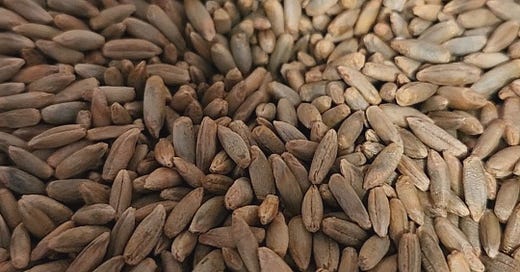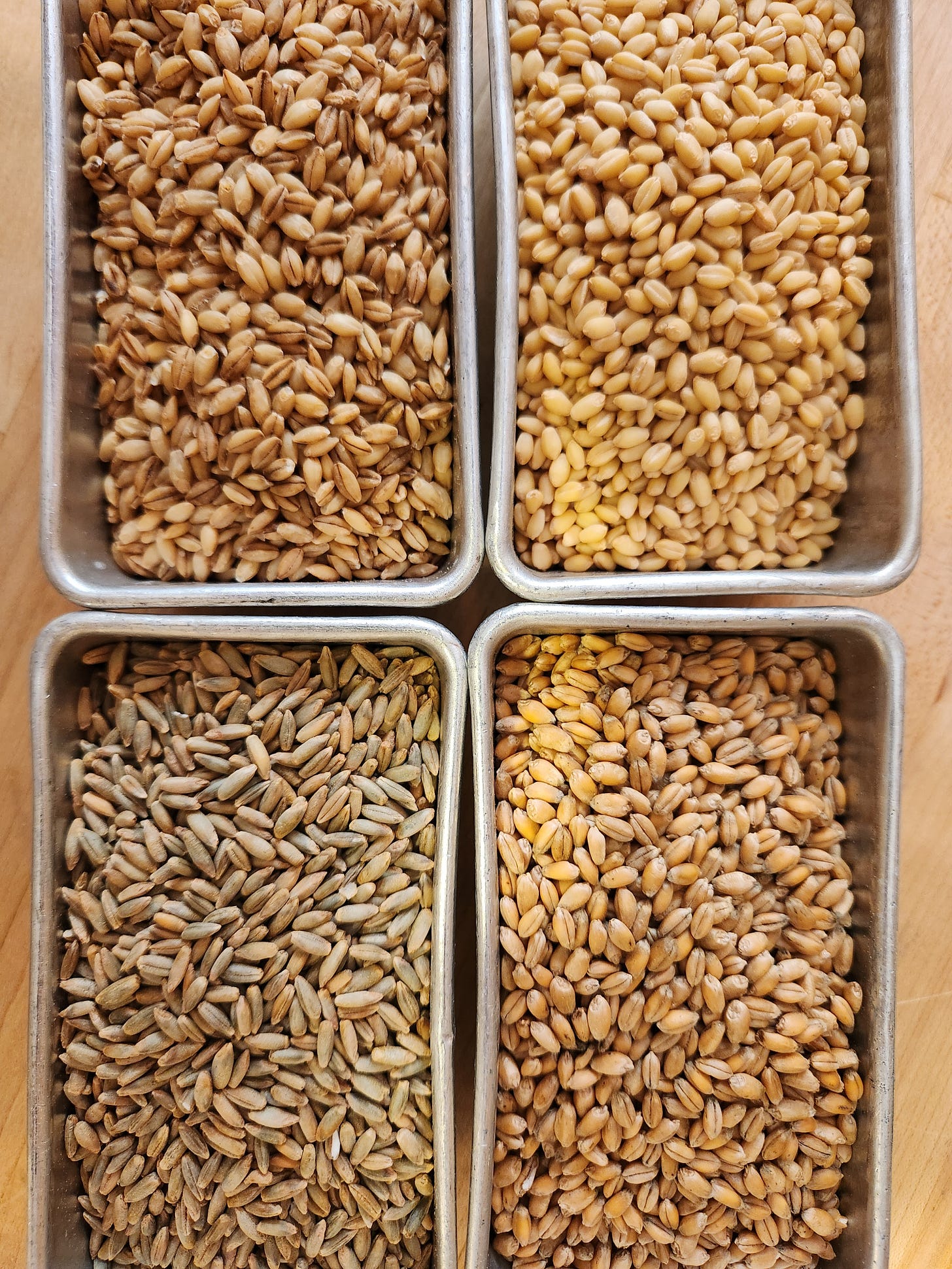This week we’re returning to rye, the hardy cereal grass we introduced a few weeks ago. We’re discussing the current state of rye flour in the U.S. and the missed opportunity to let rye’s unique flavors shine.
Rye Flour in the United States
As you’ve probably already noticed, the terminology describing flour can be complicated and misleading. The amount of bran and germ remaining in milled flour falls on a spectrum, between one hundred percent and zero percent. Any midpoint must be described in a way that informs the baker what they’re dealing with and sets them up for success with their bakes. Over the years, various terms have emerged, yet things have only gotten more confusing. This is nowhere more true than with rye.
Rye flour in the U.S. is usually described as light, medium, dark, or pumpernickel. These terms generally follow the inclusion spectrum, with light rye flour having the most bran removed, hence its lighter color. However, since there are absolutely no standards for what these terms mean, medium rye flour from one mill can be totally different from medium rye from another. To make things worse, sometimes dark rye means full-inclusion, and sometimes it doesn’t. Sometimes pumpernickel means full-inclusion, and sometimes it doesn’t. There’s even the possibility that a dark rye or pumpernickel flour contains more than the amount of bran originally present in the rye berry if a miller chooses to supplement it with some of the bran sifted out of a lighter rye flour.
How did this get to be such a mess? Well, most Americans have an incredibly limited relationship with rye. Really the only time most of us eat rye is in a sandwich at a deli. Shockingly, this rye bread is mostly not rye. Most of the grain used in rye bread is a white, or sifted, wheat bread flour. There is a good reason for this, which is that rye on its own really cannot make a light and fluffy sandwich bread. It just doesn’t form a gluten structure the same way that wheat does.
Because rye bread is mostly wheat, the percentage that is rye doesn’t affect the bread’s structure much at all. The rye flour bakers use is typically described as light. Just how light? Well, because the rye has all that wheat to lean on, it really doesn’t matter. The rye flour can be inconsistent because it’s just the supporting actor in rye bread. In the end, those of us eating lunch get bread with a perfect texture for our egg salad, and the bakers don’t have to worry about the specifics of their rye flour because not much of it is getting used at all.
Then why does my egg salad on rye taste so distinct?
To compensate for the lack of rye flavor in rye bread, bakers add caraway seeds! While caraway seeds are delicious and have a great crunch, they have become so ubiquitous in rye breads that most Americans think the flavor of caraway is the flavor of rye. Caraway seeds can even be ground on their own or with other licoricey spices before being mixed into bread dough for a rye bread that is flavorful with a perfectly smooth texture.
Caraway and rye are a winning combo for sure, but because these deli-style rye breads are our only connection to the cereal, we’re missing out on the special flavor of rye itself. Rye has a nutty flavor, and is a little bitter, spicy, and sweet all at once. Fresh rye berries can even smell like the grassy field they came from, and they are lovely colors, ranging from a neutral light brown to a grey with shiny splashes of purple and blue.
For the Full Experience, Bake it Yourself
There are many varietals of rye, and they are all so beautiful, flavorful, and unique. The current favorite at our bakery is Danko Rye, a high-yielding, open pollinated descendant of Northern European ryes. Danko was developed in the 1970s to be a great grain for milling into flour, and it is! But of course all the varietals of rye are interesting and delicious, each with their own properties that make baking with them endlessly fascinating.
If you own a flour mill, rye is a fantastic grain to play around with. Milling your own means your flour will be full-inclusion, and you can avoid all those confusing terms at the grocery store. If you don’t on a mill, you can still bake with rye. Just be sure to buy a trusted brand that is clear about how much of the bran is still present in your flour.
Rye goes great with flavors that are licoricey and pungent, but to really appreciate the flavor it brings on its own, try at least a few recipes that don’t call for caraway seeds. Because rye is assertive, it stands up well to assertive flavors, such as baking spices like ginger, cloves, and allspice.
This week’s recipe is for Ginger Rye Crisps. These sweet yet complex slice and bake crisps are the perfect accompaniment to any cheese board. They are just perfect for spreading with goat’s cheese or dipping into whipped ricotta. They’re also the perfect road trip snack, and they make a great homemade gift since they have a shelf life of several weeks. Let’s get baking!





